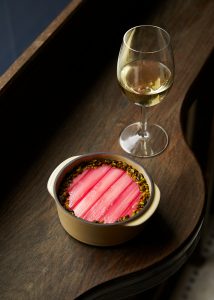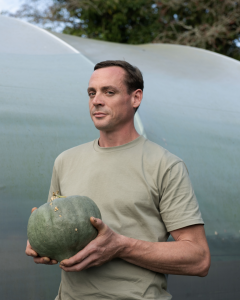Head chef Matthew Harris gives us two recipes for a long, late-summer lunch or dinner, from the kitchens of the South Kensington restaurant

Boiled lobster with broad bean purée, and lemon and caper vinaigrette (serves four)
The best lobsters, I think, are native lobsters from the Dorset coast. Every summer at the restaurant we get through thousands of them. Although available at other times of the year, they are most affordable in the summer months when they are in their prime. The amount of broad beans you need to buy will vary according to when in the summer you make this recipe. At the beginning of the summer there aren’t very many in a pod, whilst towards the end the pods are fuller and have bigger beans in them. It’s better to buy too many, any spare are delicious tossed through a green salad and served on the side. The effort involved in podding and peeling broad beans is well worth it. The richness of the purée with the juicy lobster and sharp vinaigrette is marvellous.
4 x 500g live lobsters
Salt and freshly ground black pepper
LEMON AND CAPER VINAIGRETTE
2 lemons
4 shallots, finely chopped
2 tablespoons baby capers
4 tablespoons olive oil
2 tablespoons finely chopped flat-leaf parsley
BROAD BEAN PUREE
1.5kg/3 lb podded broad beans
1 garlic clove
150ml/ ¼ pint olive oil
To make the vinaigrette, grate the lemon zest into a bowl and then peel all the pith from the lemons with a small knife. Carefully remove the flesh of each lemon by cutting in between the membrane that holds the lemon together, cutting towards the centre. Do this each side of the membrane and the lemon flesh will drop out. Discard any pips from the flesh and add it to the zest. Add the rest of the vinaigrette ingredients and mix; season with salt and pepper. Put to one side.
To make the broad bean purée, cook the beans in a large pan of boiling water for 30 seconds. Drain and cool either under running cold water or in bowl of iced water. When cold, remove the outside skin of each bean by slitting the grey outside skin with your nail and popping out the green bean inside. Discard the grey skins and weigh 150g/5oz of the beans for your purée.
Place the beans, garlic and olive oil in a blender and mix until completely smooth. For this amount of purée, I find it best to use a hand-held stick blender as you can mix small amounts and you end up with a very smooth finish. At this stage the purée will be a little too thick, so add a couple of one or two tablespoons of water and blend again until completely smooth, season and put to one side.
To cook the lobsters, you will need a large saucepan. Fill with well-salted water and bring to the boil. Now add your lobsters and boil rapidly for 10 minutes. Remove the lobsters from the water and leave to cool for 3-4 minutes until you can touch them.
Cut the lobster in half lengthways with a large chopping knife by holding the lobster flat with one hand and inserting the blade in its back behind its eyes and chopping down towards its tail splitting the bottom half in two. Then turn the lobster around so it faces the other direction and chop the top of its head in half so you end up with two pieces. Discard the dark thread of digestive tract from the tail. Remove the tails from the shells and crack open the claws to remove the meat. If the lobsters have a coral, which will turn red during cooking, it is a very nice touch to remove this and mix it through the vinaigrette before serving. Place all the meat on a dish, brush with olive oil and cover with foil to keep warm in a preheated low oven while finishing the dish.
To serve, warm the purée and then place a couple of spoonfuls on each plate, spreading it out with the back of a spoon. Place two halves of lobster tail and two claws on each plate, dress with vinaigrette and serve.

Roast Peaches with Ricotta, Almonds and Port (serves 6)
White peaches are best if you can get them. However yellow will make an admirable substitute. At the restaurant we also use apricots – just remember to reduce the cooking time.
6 peaches
200g amaretti biscuits
1 bottle port
75g butter
100g ricotta
2 egg yolks
150g flaked almonds
50ml Armagnac
zest of 2 oranges
12 tspn caster sugar
Crème fraiche to serve
In a large mixing bowl crush the biscuits with the end of a rolling pin and then mix in the butter, almonds, orange zest, ricotta, egg yolks and Armagnac by hand to form a cohesive mass. Split the peaches in half and remove the stone. Place a walnut sized piece of the filling on each half of the peach. Scatter one tablespoon of sugar over each half and place them on a roasting tray and add the port. Roast the peaches for 20 minutes at 180°c. Remove from the tray and pour the port into a saucepan. Boil and reduce to a syrup. If the port is not sweet enough add a touch more sugar. To serve give two halves per person and drizzle with the syrup and garnish with a spoonful of crème fraîche.




